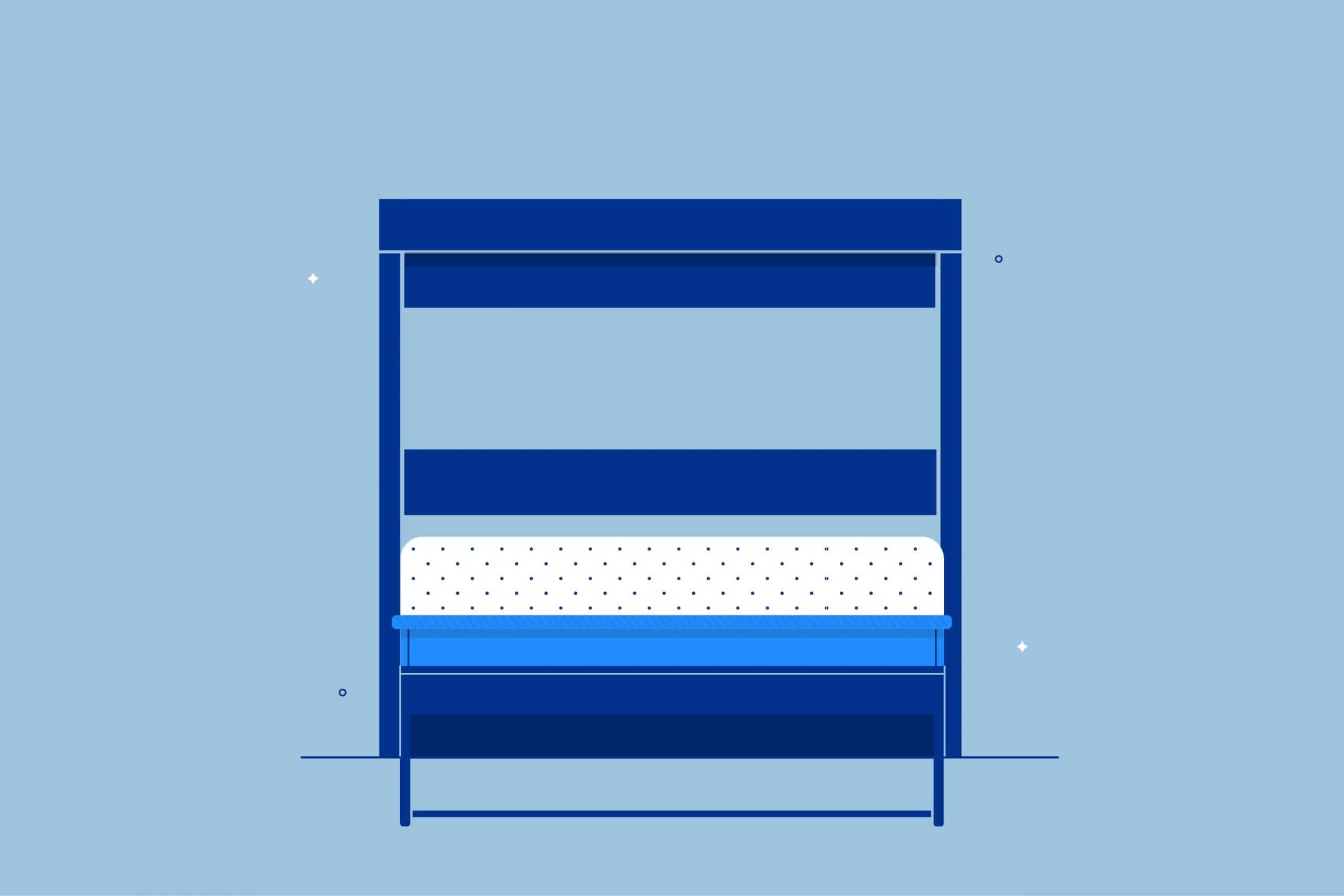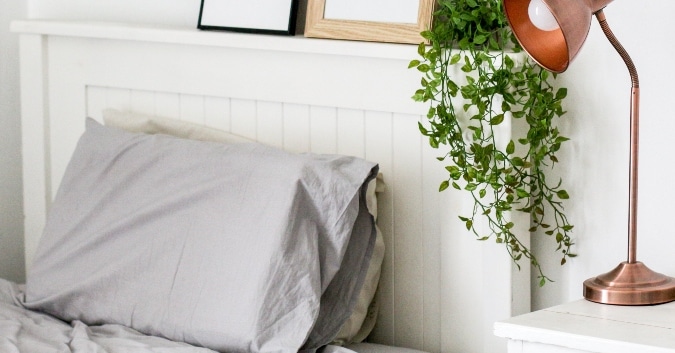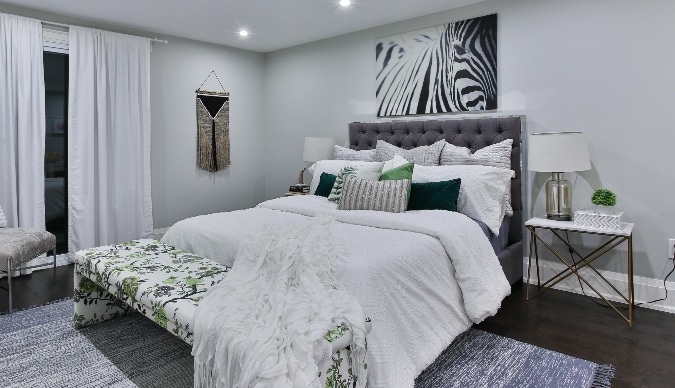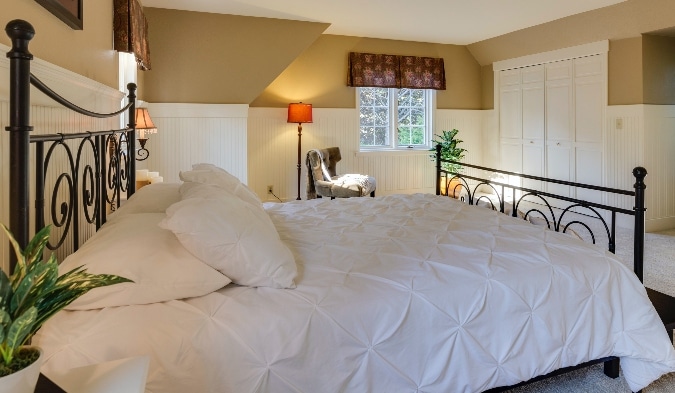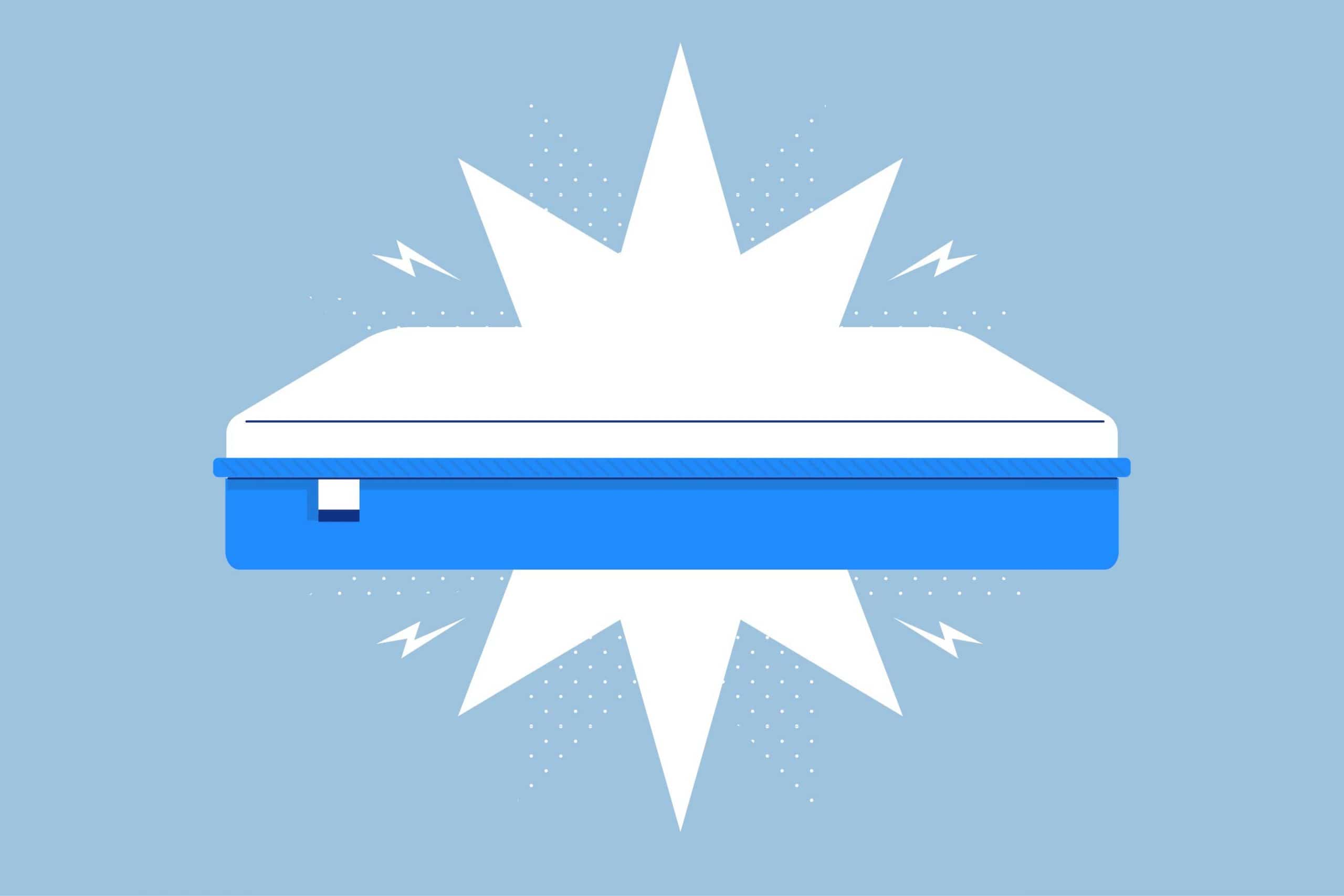Bed frames (also called bedsteads) refer to the railing for your bed, though some frames feature a headboard and footboard. The bed railing holds your foundation, which then holds your mattress.
Bed frames raise both your mattress and the foundation off of the floor, helping them stay safe from moisture build-up, dust, and mold. However, compared to basic mattress foundations or bases, bed frames are most often decorative and come in a variety of styles.
Since bed frames are merely a prop for your bed and its foundation, they work with any type of mattress. Below, we outline the various types of bed frames available and why they might work well for you.
Types of Bed Frames
Bed frames come in a variety of sizes and styles and offer unique features, such as being cost-efficient, space-saving, or multipurpose.
Platform
A platform bed is a type of bed frame that eliminates the need for an additional foundation. Rather than having one or two rails just to hold up a box spring or mattress foundation, platform beds have a slatted wood foundation to support your mattress independently. For a bed frame to be considered a platform bed, the slats must be no further than 2 to 3 inches apart.
Some platform beds are simple and only have the side railing, but other platform beds have headboards and footboards to make them more decorative.
Floating
Floating bed frames are a type of platform bed frame. Traditional platform beds have four, clearly visible legs to hoist the frame off of the floor while floating beds have discreet legs or none at all. Instead, floating beds are anchored to the wall.
Floating bed frames have a very modern look and can give a smaller bedroom the illusion of having lots of space. While you can technically use the underside of the bed for storage, it defeats the decorative appeal of a floating bed.
Sleigh
Sleigh bed frames are a decorative bed frame with a curved headboard and footboard, similar to an actual sleigh. Sleigh beds are a statement piece of furniture for your bedroom, though they can be quite costly. They’re commonly made from wood but sometimes have fabric upholstery instead.
Trundle
Trundle beds are beds with a roll-out mattress beneath them. The mattress is most often in a large drawer low to the floor, but it can also sit on a pop-up frame. Trundle beds most commonly come in twin and full sizes, but you can occasionally find a queen or king bed with a trundle.
Mattresses in a trundle are often quite thin, so they’re not the best for nightly usage. However, they work well for the occasional guest and in children’s bedrooms.
Bunk
Bunk beds are two—sometimes three—bed frames stacked over each other. Most bunk beds fit twin mattresses, but you can find some bunk beds that work with twin XL, full, queen, and even a king size mattress.
A bunk bed is great if you’re looking to maximize the space in your bedroom. It works well for kids’ rooms, guest bedrooms, and rental properties. Bunk beds are also common in college dorms.
Murphy
A murphy bed is another type of bed frame designed to maximize bedroom space. It’s a bed you store vertically against the wall inside of a closet or cabinet. During the day, you can store the bed away and have open space to use in your bedroom or studio apartment. Then at night, you simply pull the bed down and sleep on it as normal.
Murphy beds are available in many different sizes, but are most commonly designed to fit queen size mattresses.
Daybed
Daybeds are a multipurpose bed frame and have three frames to resemble a deep couch. Daybeds double as a sofa or bench during the day. All you need is a couple of pillows to make them comfortable to sit against. At night, you can use your daybed as a traditional bed. They fit regular mattresses as well, so you won’t have to worry about finding a special mattress.
Bed Frame Materials
The three most common materials bed frames come in are wood, metal, and fabric upholstery. Choosing your bed frame’s material affects your room’s appearance and primarily comes down to your personal preferences.
Wood
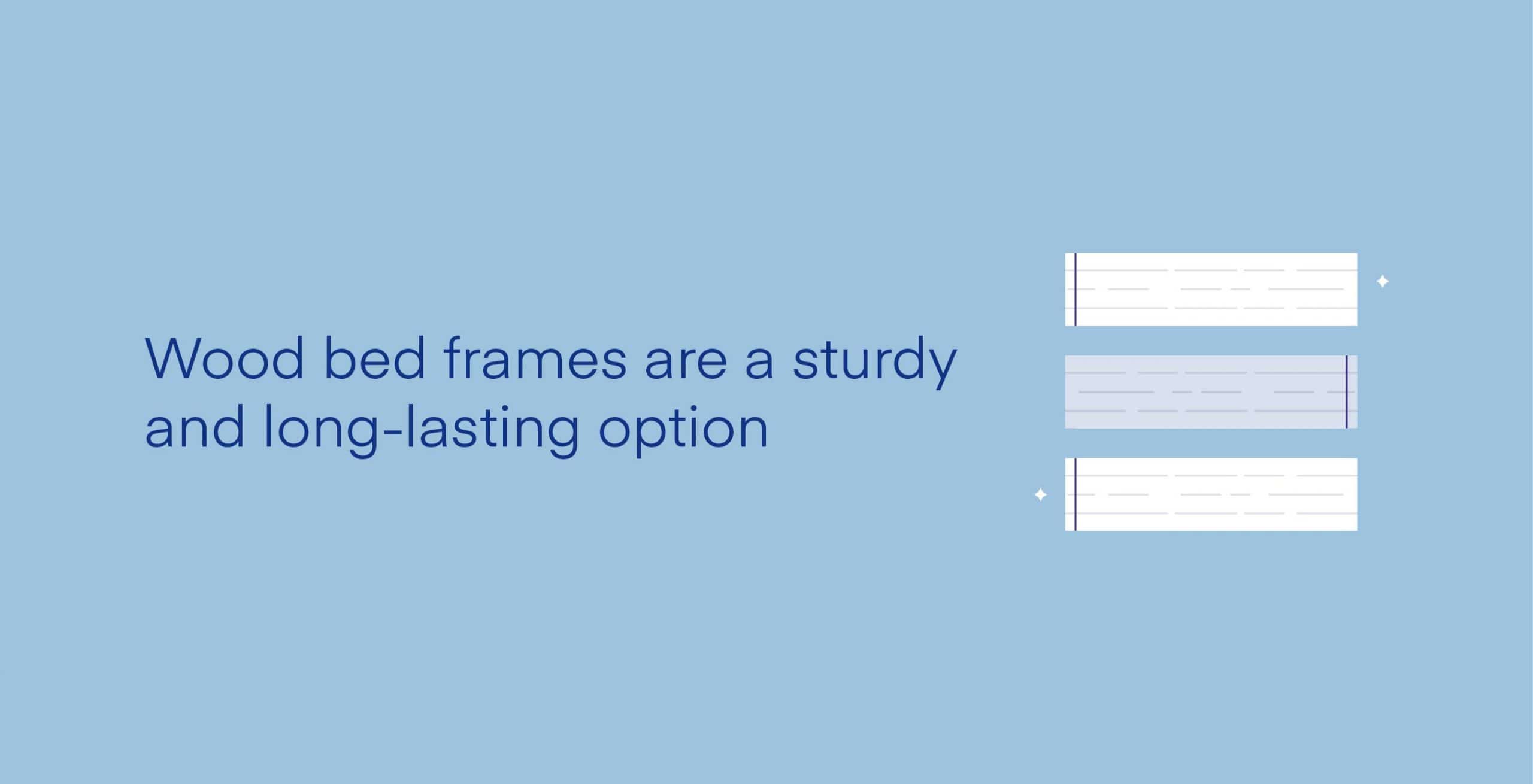
Wood is a very classic and reliable material for bed frames. Wood bed frames are usually made from 100 percent wood, medium-density fiberwood (MDF), or particleboard. Wood frames are sturdy, match with most bedrooms, and long-lasting. However, wood bed frames can get quite heavy, especially if the frame is made with real wood.
Metal
Metal bed frames are made from iron or steel. Metal bed frames are often quite minimalistic appearance-wise, though they’re also very sturdy and durable. Since metal bed frames are generally lighter than wood frames, they’re easier to transport. Unlike wood, some metal frames can be squeaky if they’re not constructed properly.
Upholstered
Upholstered bed frames have a fabric or leather casing over wood and can be very luxurious. They fit the aesthetic of both modern, contemporary and traditional homes.
One benefit of upholstered bed frames is that they come in a variety of different colors, whereas most plain wood and metal frames are neutral-toned.
Bed Frame Heights
While the height of your bed frame isn’t a crucial factor for most people, if you struggle with limited mobility, Verified Source Medline Plus Online resource offered by the National Library of Medicine and part of the National Institutes of Health. View source the bed’s total height can affect your ability to get in and out of bed.
We recommend a total bed height—your bed frame plus your mattress—of around 25 inches, or just tall enough so your knees are in line with your hips and your feet are flat on the floor when you’re seated at the edge of your bed.
Bed frames are available in three heights, or profiles: low, standard, and high.
Low Profile
Low profile beds are close to the floor and are less than 13 inches tall. A low profile bed frame looks great aesthetically in a simple, minimalistic bedroom. It also works well if you have a small bedroom, but want to give it the illusion of being spacious. However, low profile bed frames often come with little to no space for storage under the bed.
Standard Profile
Standard profile bed frames are the most common bed frame height. They are 13 to 15 inches tall, making them high enough off of the floor so you can use the underside as a storage space without being overly tall.
High Profile
High profile bed frames are taller than 15 inches. Tall bed frames look nice in bedrooms with high ceilings as they fill up the vertical space in the bedroom. High profile bed frames also work well if you plan on using the underside of the bed to store lots of items.
Pros of a Bed Frame
- Most frames provide under-the-bed storage
- Lift your bed off of the floor, ensuring your bed is clean
- Add a decorative flair to your bedroom
- Some frames don’t require an additional foundation, saving you money
Cons of a Bed Frame
- Some frames can get quite costly, especially if you need to purchase a foundation
- Low and high profile frames can be difficult to get in and out of
FAQs
Can a bed frame ruin a mattress?
If you use your bed frame incorrectly, it can potentially wear your mattress down. Unless you’re using a platform bed frame, most bed frames are incapable of supporting a mattress independently.
You should place a mattress foundation or box spring between your mattress and your bed frame. Without the proper foundation, a bed frame doesn’t have enough slats or rails to support your bed, causing your mattress to sink and sag.
Can you use a bed without a frame?
You can use your bed without a frame, but always use a mattress foundation or box spring to keep your bed off of the floor. Your mattress foundation supports your mattress and lifts it off of the floor, while most frames are merely a decorative casing for your foundation and bed.
We don’t recommend using your mattress directly on the floor without an additional foundation. The floor often carries bacteria, dust, and bugs and has a cold draft. Your mattress also won’t get proper airflow when directly on the floor, so it’s more susceptible to mold and mildew growth. Above all, using your mattress on the floor voids nearly all mattress warranties.
Does a bed need a headboard and footboard?
For the most part, headboards and footboards are decorative elements to a bed frame and aren’t required. If you’re taller, you may even bump your feet on the footboard, which can get annoying when you’re trying to sleep.
What is the difference between a bed frame and bed rails?
Bed frames are supportive railing with four sides. They’re designed to support your mattress and mattress foundation without connecting to a headboard or footboard.
Conversely, bed rails are two independent side rails used to connect a headboard and footboard and secure the bed. Some bed rails have a center support rail to better carry your mattress and its foundation.
How do you fix the gap between a mattress and a bed frame?
Bed frames have slightly larger dimensions than their corresponding mattresses to ensure the mattress will fit in the railing. However, you are sometimes left with a small gap between your mattress and the frame, causing your mattress to move around at night.
We suggest using a thin pad, yoga mat, or towel between your mattress and the frame to keep your bed in place. You can also use non-slip adhesive strips between your mattress and the foundation to stop the mattress from shifting.
Conclusion
A bed frame isn’t always an essential element to your sleeping set-up, but it makes for a great focal point in a bedroom. If you’re trying to save space, bunk beds, trundle beds, and daybeds offer great value. If you want to save money, platform beds and floating beds are a good option since you won’t need an additional foundation for your bed.
About the author
Geoff McKinnen is a writer focusing mainly on the healthcare industry and has written articles on everything from foods to help you lose weight to the connection between Alzheimer’s and sleep. Geoff’s passionate about helping readers improve their well-being to lead happier lives. Outside of work, Geoff enjoys cycling and hiking and believes that by leading a healthy lifestyle, he can help others do the same.
View all posts